Mahurangi Action phase-1 Te Muri submission
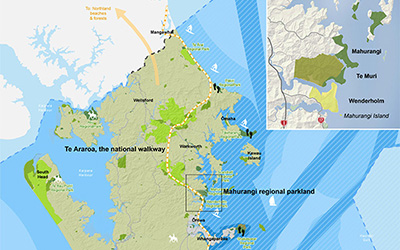
As submitted 19 August 2015
Preface
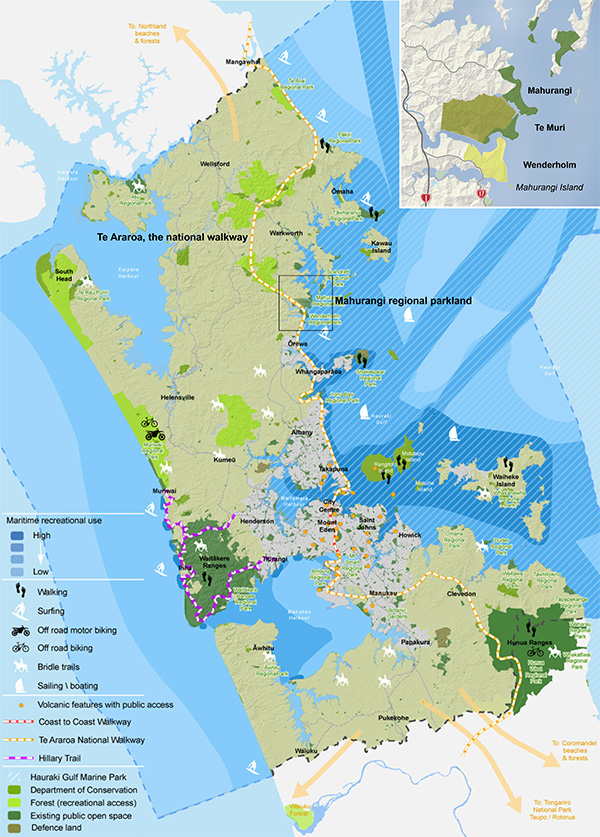
Greater than the Sum of the Parks: Even with the 407-hectare Peter Schischka farm added in, in 2010—it was somehow omitted from this 2012 map—the combined Mahurangi regional parkland, see insert, is made to look miniscule by that of the mighty Hūnua and Waitākere ranges. Visitors to Mahurangi, Te Muri and Wenderholm regional parkland should be encouraged to know they are stepping into a 900-hectare regional park estate, and the surest way of achieving that would be for it to be known collectively as the Mahurangi Regional Park—taking its name, ultimately, from the sea-stack island pā off Waiwera. map and insert Auckland Council annotation Mahurangi Magazine
Mahurangi Action Incorporated (established 1974 as Friends of the Mahurangi) is well known to be the initiator of the Mahurangi Coastal Trail concept. This unapologetic focus on the proposed coastal trail and Judge Arnold Turner Footbridge across the Pūhoi River, however, is symptomatic of the society’s comprehensive vision for Te Muri and indeed for the greater Mahurangi and Wenderholm regional park estate. Focus on the coastal trail should not be interpreted as evidence of narrow preoccupation with just one aspect of planning for the new Te Muri parkland.
The addition of the 407-hectare Schischka farm to the adjacent Wenderholm and Mahurangi regional parks demands that the combined estate be considered as a whole. Visitors to Wenderholm, for example, deserve to know that they are stepping into a 900-hectare regional park. This, of course, is the situation in both the Hūnua and Waitākere regional parks, where specific localities are named but nevertheless form part of their greater parks.
Contents of this submission
- Greater Mahurangi regional park
- Greater visitor numbers without losing Te Muri’s charm
- Mahurangi Coastal Trail concept
- Waiwera – northern metropolitan transport terminus
- The obvious Te Araroa connection
- Putting remote in remote camping
- Group shelters
- Trekking to and through, not from within
- Te Muri as an indigenous forestry exemplar
- Sensitive Te Muri sandspit, the urupā, and sea-level rise
- Mahurangi marine reserve
1 Greater Mahurangi regional park
Although the motorcar has wrought profound changes to civilisation during the last 110 years, its impact was slow to be felt in the Mahurangi and surrounding districts, due to the difficulty of building and maintaining all-weather roads. This means that the primary means of transportation, from Polynesian settlement to the end of the steamboat era of the 1930s, was by water. The notably short period that the private motorised vehicle has dominated thinking about how people take their leisure should not be allowed to obscure a more objective vision for the development of the greater Mahurangi regional parkland. Existing car-centric thinking, unless challenged, would see Mahurangi, Te Muri and Wenderholm developed, used and managed as three separate parks. This would greatly diminish the value and potential of the 900-hectare Mahurangi regional park estate.
An overarching need is to optimise the positive public health impact of the regional parks network. Reducing private car use has been found to be one of few things that significantly address the epidemic of non-communicable diseases that threatens to overwhelm the health systems of developed countries. The benefit of the more active lifestyles that accrues to people who walk and cycle even extends to the users of public transport, due to the slightly higher level of physical activity involved. The regional parks network could and should make a deeper contribution to more-active lifestyles, and the obvious opportunity, in respect to this long-term planning process, is to position Te Muri as the prize for the comparatively small amount of physical effort invested walking or cycling to that precious destination.
It is the view of Mahurangi Action that the long-term future of the Mahurangi, Te Muri and Wenderholm regional parks is for them to function as one contiguous park, and that consideration should be given to using the title Mahurangi Regional Park to encompass the constituent localities.
2 Greater visitor numbers without losing Te Muri’s charm
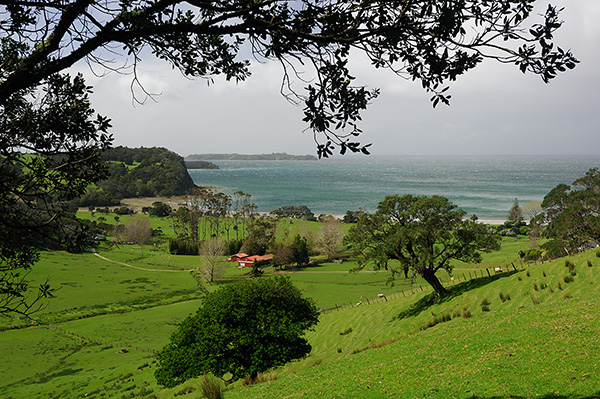
Sense of Splendid Isolation: Only an hour’s bus ride from the principal business district of New Zealand’s by far most populous conurbation, the most remarkable feature of Te Muri is potentially at risk if the new parkland is developed in the car-centric, mid-1900s thinking appropriate at the inception of the regional parks, but long since in need of updating. image Auckland Council
Coastal Te Muri was purchased to provide Aucklanders with greater access to their beaches. When Mahurangi West locals persuaded the regional council to develop Te Muri for walking access only, 27 years ago, the intention was for access to be developed that would allow a much greater number of people to visit, initially via a footbridge across Te Muri Estuary, in a visually unobtrusive, upstream location. The greater vision was for a Mahurangi Coastal Trail, to make Te Muri readily accessible to the large number of regular Wenderholm Regional Park visitors.
The intended access failed to materialise, despite Mahurangi Action regularly submitting that it should be. There are now generations of Te Muri adherents, and many of them are opposed to any change to the current, tide-dependent, pedestrian access. This does not necessarily reflect a selfishness of outlook, but rather a profound appreciation of the sense of splendid isolation that Te Muri currently affords. It behoves all those involved in the planning for the long-term future of Te Muri to nurture this sense of isolation by rigorously exploring every reasonable means of accommodating the significantly higher numbers of visitors without those same visitors feeling crowded.
With one notable exception, Te Muri has always enjoyed an unbuilt ambiance. That exception is the residence built by Peter Schischka, later in his life but never occupied, overlooking Te Muri Beach. This one, incongruous, building exudes an unfortunate proprietorial presence that impinges on the public-domain essence of the land. Long-term, the house should be demolished; in the medium term, converted to a public use such as a visitor centre. Either way, it should be largely screened so as to reduce its visual obtrusion.
Mahurangi Action is aware that some Mahurangi West property holders contend that Sullivans Bay should be developed for trailer-boat access, in the belief that it would reduce demand for such access at Jamieson Bay and Ōpahi. Mahurangi Action strongly disagrees with that proposition, in the knowledge that such an activity would quickly overwhelm all other uses of the regional park there, and generate undesirably high levels of traffic on Mahurangi West Road and Ngārewa Drive. This position holds even more emphatically for Te Muri.
It is the view of Mahurangi Action that all practicable options should be explored for retaining Te Muri’s sense of isolation, by keeping it car-free, and, for example, providing picnic areas adjacent to, but partly screened from, the beach. Provision might be made, however, for access by vehicles primarily equipped for the disabled. Particular attention should be paid to reducing the obtrusiveness of the Peter Schischka house.
3 Mahurangi Coastal Trail concept
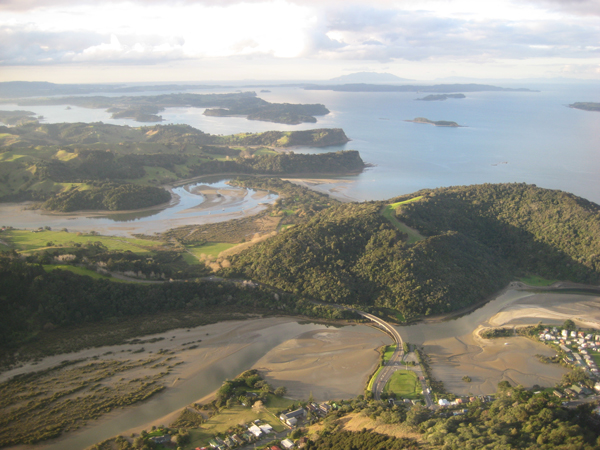
Sublime Coastline for Trail: The compulsion to traverse the coastline is an innate human attribute. For a coastline free of habitation to be at the northern metropolitan transport terminus, and be in public ownership, utterly demands it be accessible via a coastal trail. image ImageShack
Key to retaining Te Muri’s sense of splendid isolation is, of course, developing a Mahurangi Coastal Trail as the area’s principal means of access. While such a trail would greatly increase visitor numbers, its impact on Te Muri’s sense of timelessness would be infinitely less than that of parking areas containing hundreds, if not thousands, of cars. But nor would a coastal trail preclude the development of private car access in the future, in the event that, as some might argue, too few visitors would ever access Te Muri by foot, by bicycle or on horseback to justify the $15 million acquisition of the 407-hectare Schischka farm.
Aside from a duty to protect Te Muri’s much-lauded sense of isolation, the opportunity to develop a significant coastal walkway must be a paramount consideration during this pivotal, long-term planning process. A major geographical feature of Aotearoa is its extensive and richly variable coastline. Given the universal allure of the coastline, Aotearoa’s is at least as important as its Southern Alps. Along with Te Araroa—the national walkway—and its increasingly iconic cycleways, Aotearoa should strive for its coastal walkways to be world-renowned. For Aucklanders, that which is immediately north of Waiwera is potentially the most accessible, non-urban coastline of significance. Rewards such as exclusive access to Te Muri are exactly the inducement needed to encourage Aucklanders to become active greenway users.
It is difficult to overstate the strategic importance of the proposed coastal trail. Not only would it solve the impasse in the terrestrial Te Araroa section between Wenderholm and Pūhoi, it links, via that section, to northeastern Rodney via the network proposed by the Matakana Coast Trails Trust, and another, in time, across the Mahurangi Harbour to connect with the Scotts Landing and Mahurangi Peninsula components of Mahurangi Regional Park, and northward to link to the northeastern Rodney coastal settlements.
There is strong public interest in the Mahurangi Coastal Trail concept that reaches back to 1988 but is now snowballing in this golden age for greenways. A Mahurangi Coastal Trail Trust is being established, by Mahurangi Action and Friends of Regional Parks, to raise funds for a proposed ‘Judge Arnold Turner Footbridge’ to cross the Pūhoi River. Rather than descend into the detail of the proposal here, the Mahurangi Coastal Trail Technical Document is included as part of this submission.
It is the view of Mahurangi Action that a Mahurangi Coastal Trail should be developed immediately as the initial means of providing public access to the new Te Muri parkland, and that access by private vehicle should only be developed in the unlikely—Mahurangi Action would suggest—event the trail was little used.
4 Waiwera – northern metropolitan transport terminus
Wenderholm is the northern-most regional park that is accessible by public transport. Nor is there any prospect of any of the further seven regional parks to the north being accessible by public transport, except by the proposed Mahurangi Coastal Trail. For Aucklanders to be able to access a 900-hectare regional park estate, beyond the suburbs, by an hourly, one-hour bus ride from Queen Street, is profoundly significant in respect to the ideal of universal accessibility of these parks. Ideally, initially during weekends and public holidays, the bus terminus would be moved to just inside the entrance to Wenderholm Regional Park.
Alternatively, what Auckland Transport terms, a fourth-tier targeted service could operate between Waiwera, the Judge Arnold Turner Footbridge, Wenderholm beach and, potentially, Pūhoi. Such a service could readily be manned by volunteers, and if experience elsewhere is any indication, the vehicle running costs met or exceeded by gold-coin donations.
It is the view of Mahurangi Action that every practicable means of increasing the accessibility of the Mahurangi, Te Muri and Wenderholm regional parks from the public transport terminus at Waiwera should be explored and exploited.
5 The obvious Te Araroa connection
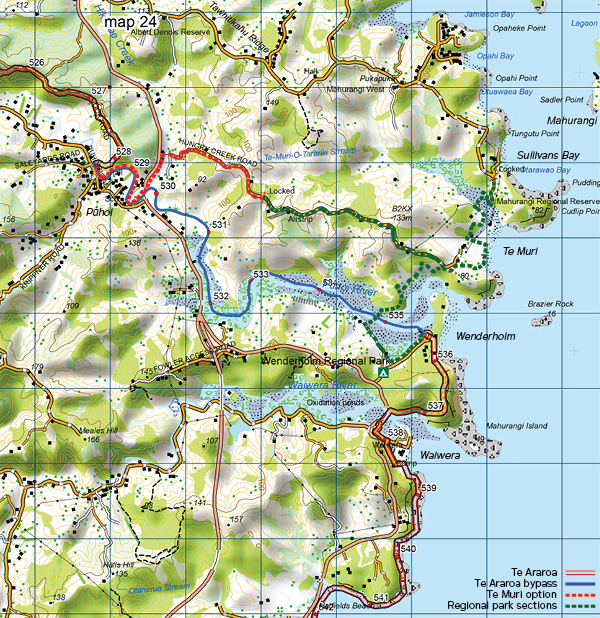
Obvious in the Short-Term Future: When completed, the Mahurangi Coastal Trail, and the missing Te Araroa section it will facilitate, will strike all who encounter it as entirely obvious—few will think for a moment that the concept was once considered by some as fanciful. map Te Araroa Trust labels Mahurangi Magazine
Given the rural and coastal panoramas it provides, its geographical logic, and its public domain status, it would be perverse in the extreme to fail to have the main ridgeline spine of Te Muri form the principal route of Te Araroa. Likewise, to have the sections that take Te Araroa from Pakiri via Mount Tamahunga inland and back to the coast after Pūhoi, and fail to emerge at the coast in the jewel of isolation and beauty that is Te Muri, would be an omission of epic proportions.
The greatest significance, however, of the proposed Pūhoi–Te Muri section lies in its potential to introduce more New Zealanders to Te Araroa than any other section. This opportunity exists because of Wenderholm’s strategic position at the beginning of the first non-urban section of Te Araroa north of the metropolis. Even from existing Wenderholm visitors, the number of potential first-time users of Te Araroa would be prodigious, but were Waiwera and Wenderholm marketed as ‘the gateway to our national walkway’, in concert with the Mahurangi Coastal Trail, the increase of awareness of ‘New Zealand’s long trail’ would be nationally significant.
The importance of the ridgeline farm road of Te Muri as a scenic trail of national significance indicates that its vehicular use should be kept to an absolute minimum. Also, it is imperative that any new planting for amenity, biodiversity, soil conservation or other purposes should not impinge on the panoramas available from the ridgeline trail, or from its attendant spurs.
It is the view of Mahurangi Action that the proposed Pūhoi–Te Muri section of Te Araroa is of overwhelming local, regional and national importance, and that Hungry Creek Road and the scenic ridge farm road route must be protected from non-essential vehicle use, and enjoyment of its panoramas protected.
6 Putting the remote in remote camping
It is incongruous that the existing campground permits only cheek-by-jowl camping, given the area’s remote-camping designation. The new concept plan for adjacent Sullivans Bay, in contrast, hints at how camping can be accommodated in a style much better matched with Te Muri’s sense of splendid isolation. In the short-to-medium term (see below at Te Muri Sandspit, the urupā, and Sea-Level Rise), with appropriate planting, ample, suitably free-draining ground exists on Te Muri’s greater sandspit to create campsites that afford a sense of remoteness. The area currently is largely devoid of trees and is quite inhospitable on hot summer days, or when windy. This sparseness of cover compares very unfavourably to the equivalent Wenderholm sandspit, which is dominated by mature pōhutukawa.
It is the view of Mahurangi Action that remote camping is a proven need at Te Muri and that there is considerable scope to both improve the experience by decentralising the activity and to accommodate many more remote campers than at present.
7 Group shelters
Via the proposed Mahurangi Coastal Trail, Te Muri is well suited to both day and overnight visits by groups of school children. New Zealand’s famously changeable weather, however, is a disincentive to those bearing the responsibility for organising valuable, out-of-the-classroom experiences for young New Zealanders. Te Muri is particularly well suited to this activity, given the availability of public transport, which is only lightly patronised during off-peak hours on weekdays.
Open-sided shelters, measuring about eight by eight metres, would provide shelter for groups young and old from sun and rain, and—with lightweight tarpaulin carried by the visitors, rigged to provide protection—from wind. Built with appropriate materials, and surrounded by suitable planting, the shelters could be camouflaged into virtual invisibility to preserve the predominantly unbuilt ambiance of Te Muri.
It is the view of Mahurangi Action that a group shelter should be trialled at Te Muri, particularly to encourage schools to help introduce young people to a non-digital environment.
8 Trekking to and through, not from within
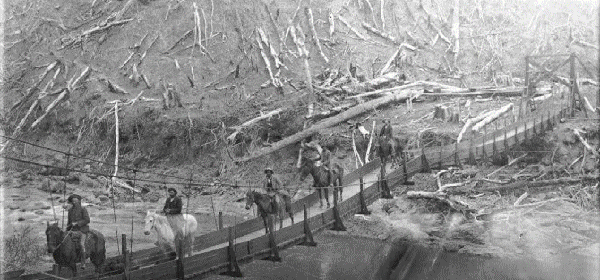
Heritage on Horseback: HoHorses played a pivotal role in the settler development of Aotearoa, and no more so, and until surprisingly recently, here, north of Auckland. While it is not currently envisaged that the Judge Arnold Turner Footbridge would carry horses, that option deserves exploration, as do the alternatives of facilitating the fording of the Pūhoi River, at the traditional point immediately downstream, and of establishing a charitable-trust-owned stables at Spaniards Creek. image Credit pending
Mahurangi Action strongly supports the views submitted by the NZ Horse Network on 29 July 2015, particularly the network’s rejection of a vehicle-centric approach to addressing the interests of horse riders. Used as the NZ Horse Network suggests, as a place where riders can ride to and through, as opposed to around from within, Te Muri could accommodate many such users without impinging on non-horse-riding visitors. If, however, the Hungry Creek Road and the Schischka farm road were used for private vehicles towing horse floats, and other motorised horse transport, that highly scenic route would be chronically degraded as, what would otherwise be, a sublime section of Te Araroa. Horses typically revel in a steep climb early in a ride, such that it would be contrary to cause or encourage their owners to transport them from sea level to an altitude of 120 metres, before commencing.
The needs of horse riders, and aspiring horse riders, are not necessarily the same as the needs of horse owners, and the former formidably outnumber the latter. The Spaniard Creek flat might be investigated as the site of a stables from where park visitors might hire animals, including for guided rides. Such an egalitarian use of a regional park should enjoy a much higher priority than the use of any part of Te Muri for horse float and transporter parking.
It is the view of Mahurangi Action that Te Muri should be developed to encourage horse riding to and through it and adjoining parkland, rather than as a place to transport horses into. Sites such as Spaniards Creek should be investigated as locations for charitable-trust-owned stables supplying mounts to park visitors.
9 Te Muri as an indigenous forestry exemplar
Until European settlement, Te Muri, like much of Aotearoa, was mostly forested. There is now a rapidly growing appreciation that indigenous forestry can restore much of the lost biodiversity, without abandoning opportunity for economic return. Parts of Te Muri would make excellent demonstration sites for planted indigenous forestry, particularly given its proximity to Aotearoa’s largest urban settlement. Indigenous forestry is a natural fit with the regional parks working-farm-park model, and would meaningfully complement existing regrowth and new plantings, which exist for purely conservation purposes. Farm forestry of indigenous species would be fully compatible with the North-West Wildlink concept, and its extension to Scandretts, Kawau and Tāwharanui, and on to Little Barrier.
It is the view of Mahurangi Action that a role for indigenous forestry should be investigated at Te Muri.
10 Sensitive Te Muri sandspit, the urupā, and sea-level rise
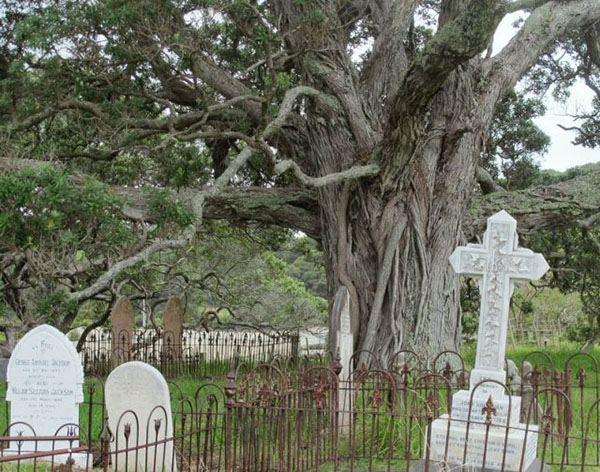
Doomed by Locked-In Sea-Level Rise: The five metres of sea-level rise already locked in by anthropogenic greenhouse gas emissions, means that a new, permanent home at a much greater elevation will need to be found for the human remains and headstones of the barely-above-sea-level Te Muri urupā. image Ross Davies
The sandspit of Te Muri is acutely sensitive and vulnerable culturally, ecologically and geomorphologically. The proximate vulnerability is particularly the head of the spit’s function as nesting place of seabirds—most critically, of the endangered New Zealand dotterel. The proposed Mahurangi Coastal Trail has considerable potential to mitigate human disturbance of this sensitive area by channelling the bulk of walkers to a crossing point 350 metres upstream.
Culturally, it is the urupā at Te Muri that is probably the most vulnerable site, although the pā archaeology at Te Muri Headland also requires protection, but this is more than 500 metres from the proposed coastal trail. Similarly to its protection of the nearby seabird nesting area, the coastal trail has the potential to channel walkers away from the urupā, not so as to discourage visitors from experiencing it, but to help ensure that when they do so, it is in an appropriately mindful manner. Consideration, long term, should also be given to operating Te Muri off the national electrical grid, and thus dispense with the overhead power lines that, despite the commendable recent rerouting, continue to obtrude on the sanctity and sense of timelessness of the urupā and on the aesthetics of the estuary, where they also pose a particular hazard, or unnecessary impediment to, multihull and other shoal-draft yachts.
Longer term, Te Muri sandspit is profoundly vulnerable to the impact of anthropogenic sea-level rise. Last month, the world’s most respected climate scientist, Dr James Hansen, and others, published a paper warning that the sea-level rise projections of the Intergovernmental Panel on Climate Change seriously low-ball the likely range. A combination of multi-metre sea-level rise and more violent storms means that it is entirely possible that the sandspit of Te Muri will be inundated and destroyed this century. Regardless of the actual rate of change, priority must be given to management of the sandspit so as to increase its resilience to erosion, with particular emphasis on sand-binding plants and appropriate back-dune vegetation. Measures similar to those undertaken at neighbouring Wenderholm, in respect to protecting sand-binding plants, must be a priority.
Development of the proposed Mahurangi Coastal Trail is consistent with mitigating the greenhouse gas emissions that are the cause of sea-level rise. Tragically, the latency of climate change means that sea-level rise of at least 5 metres is already locked in, and a further 15-metre rise is inevitable without ‘fast, drastic action’, of which there is no sign. It is important morally and symbolically, however, that the new Te Muri parkland is developed in a way that, at the very least, does not exacerbate sea-level rise.
It is the view of Mahurangi Action that regardless of the merits of the proposed Mahurangi Coastal Trail, the proposed crossing of Te Muri Estuary is required to protect the vulnerable head of Te Muri sandspit, and the urupā. Every practicable measure must be taken [to] increase the natural resilience of the spit, with particular emphasis on dune and back-dune vegetation.
11 Mahurangi marine reserve
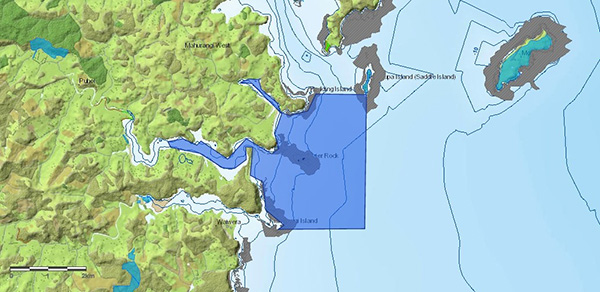
Natural Sentinel Option: This concept for a 944-hectare Mahurangi marine reserve nicely utilises the natural sentinels provided by Pudding, Saddle and Mahurangi islands. It is one of a number of areas identified by Dr Roger Grace in his Hauraki Gulf marine spatial plan role—it is currently before the stakeholders working group—that, combined, would nevertheless occupy only a very small percentage of the total gulf coastline. concept map Dr Roger Grace
With the successful upgrading of the marine park at Tāwharanui to a full marine reserve, the increasing expectation of visitors is for marine protection to be part of the regional parks experience. In 1991, a questionnaire circulated by Mahurangi Action to its members and to 3000 households in the wider Mahurangi area found 82% of respondents volunteering that by 25 years hence—by 2016—they wanted a no-take marine reserve to occupy all or part of the Mahurangi Harbour, and the coastline of Te Muri and Wenderholm. The 1992 joint submission to the Mahurangi Regional Park management plan, by Forest and Bird, iwi, Mahurangi Action and the Mahurangi West Residents and Ratepayers Association, included:
The possibility of establishing a no-take marine reserve [that] included areas of the Mahurangi and Wenderholm regional parks should be discussed with all interested parties.
This review of the Auckland Regional Parks management plan is an appropriate time to invite discussion of a Mahurangi marine reserve, and its potential boundaries, such as between the natural sentinels of Pudding Island, off Cudlip Point, and Mahurangi Island, off Waiwera.
It is the view of Mahurangi Action that iwi should be consulted regarding the possible establishment of a marine reserve off part or all of the coastline of the Mahurangi, Te Muri and Wenderholm regional parkland, with view to a wider exploration of Mahurangi marine reserve concepts forming part of this planning process.
Personal communication New Zealand Walking Access Commission regional field advisor for Northland, John Gardiner: Thoroughly enjoyed the [inspection of the proposed Mahurangi Coastal Trail route] and reckon you are onto a winner.
Attachment Mahurangi Coastal Trail Technical Document, as submitted 19 August 2015
